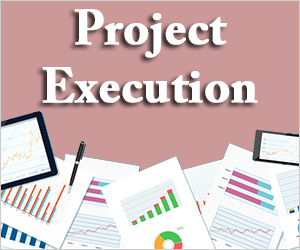
After project planning is complete, and a strong project plan is in place that manages the stakeholders’ expectations, the project work must begin. The resources are acquired, the people are trained and the project moves into the execution phase.
At this point all of the project plans are put into motion, and any changes must be reflected back in a revised project plan.
This phase is generally where project management transitions from a science to an art. Although there are still many structured project management tasks during project execution, balancing the needs of diverse stakeholders, project team members, and executives can only be described as an art form. Dealing with the inevitable project changes and negotiating delicate compromises are not optional skills – They are par for the course.
The Project Team
During project execution, the project team is a biggest consideration since they are carrying out the technical work of the project. This is demonstrated by the fact that three out of eight processes within the execution group in the PMBOK guide are within the Project Human Resources knowledge area. Since the project team are not robots (at least not on my projects), their needs and wants are difficult to itemize in a structured way. That being said, there is a basic framework for treating employees which can be referenced by the project manager.
To ensure the best possible project outcome, the acquisition, development and management of the project team is one of the most important parts of the project manager’s job description. The project manager must ensure that:
- the team is equipped with the right tools to complete the job
- interacts well with the other team members, and
- is motivated to provide the highest quality of work.
Project team members need job satisfaction, which sometimes seems like a highly elusive goal. Educated professionals need continual learning possibilities and challenging work. Managers need to know they have decision making authority without being undermined. Workers need to know they have job security. Everyone wants to make a difference and their contributions should be recognized.
Most people value work-life balance, which has no single definition. It could mean flexible work arrangements to allow for time with children. Or it could mean a shorter commute.
The environment in which people work is also important. The relationships between co-workers, bosses, and subordinates should be monitored to make sure there are no conflicts. If someone feels they need to leave the project to be happier, the cost is almost always higher to train someone new than to keep what is already there.
Stakeholders
There are many examples of project managers thinking they did a fantastic job and the project was a rousing success because it was on time or budget only to find out that a client wasn’t satisfied. Indeed, it is the stakeholders, not the project manager, that decides the success or failure of a project. For this reason, stakeholder management is essential.
The project management plan should identify all stakeholders and identify how their expectations will be managed. During execution it is very important that stakeholders are managed according to the plan. If necessary, project deliverables can be vetted and approved, or the project can hold back from entering the next phase.
When information surfaces that a stakeholder is not satisfied, appropriate action must be taken to get them back on side. If the management of a stakeholder must change during the project, the project management plan should be updated.
Communication
The communication plan, developed during the planning phase as part of the project management plan, identifies the communication requirements for the project. Things such as progress reporting, investor updates, and the like must be carried out according to plan. Furthermore, any communication above and beyond that is still necessary, especially when unexpected issues pop up.
Quality Assurance
During the execution phase, the project manager must audit the systems in use by the project as it relates to quality. This can range from basic reviews and inspections for small projects to full external audits for large projects. Quality Assurance is performed in tandem with Quality Control, which seeks to measure the quality of the finished results produced by the project.
